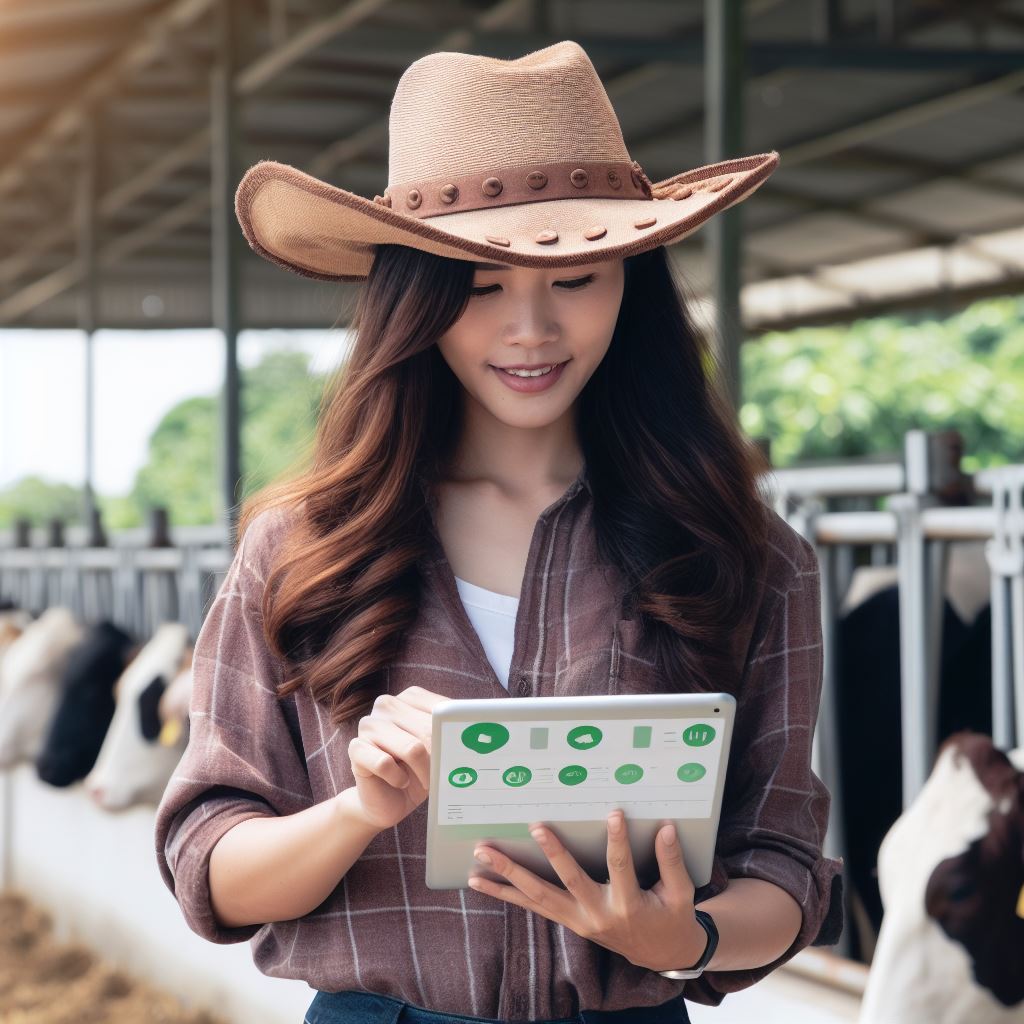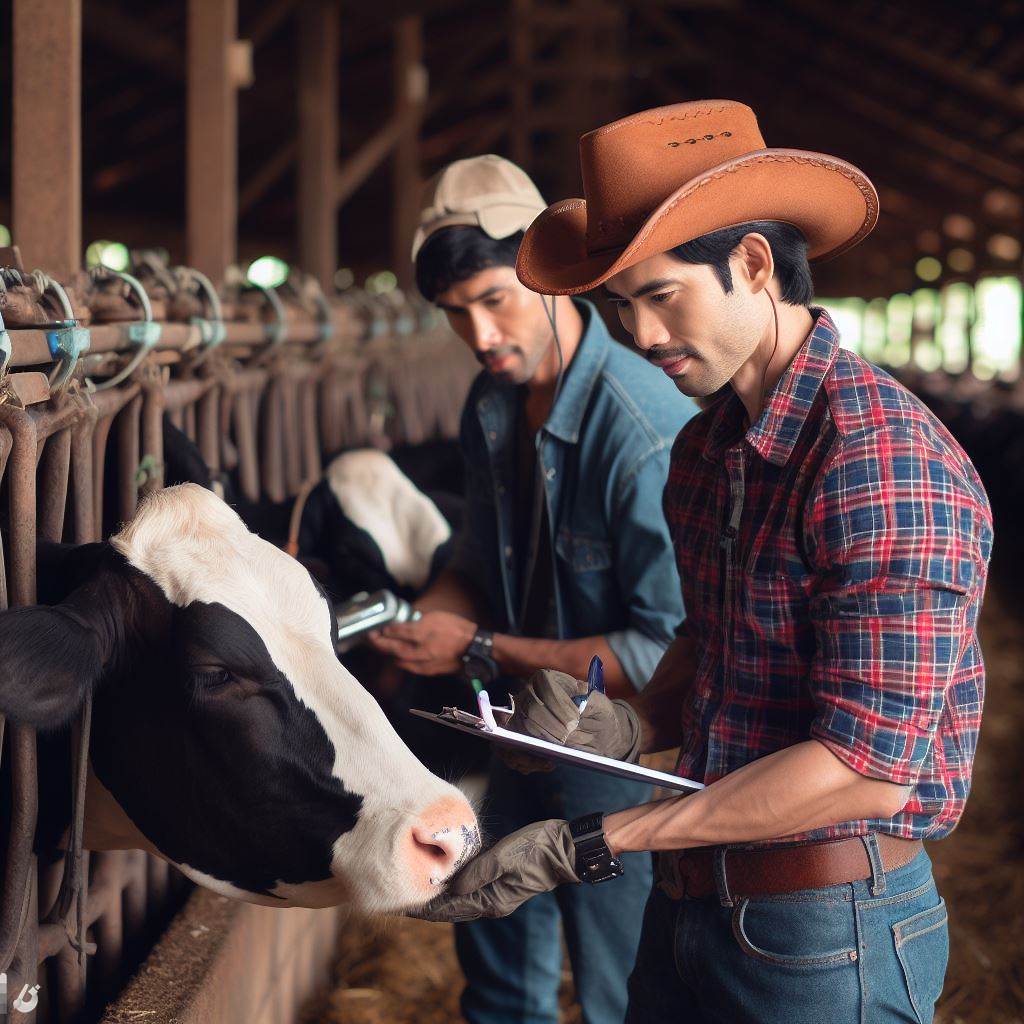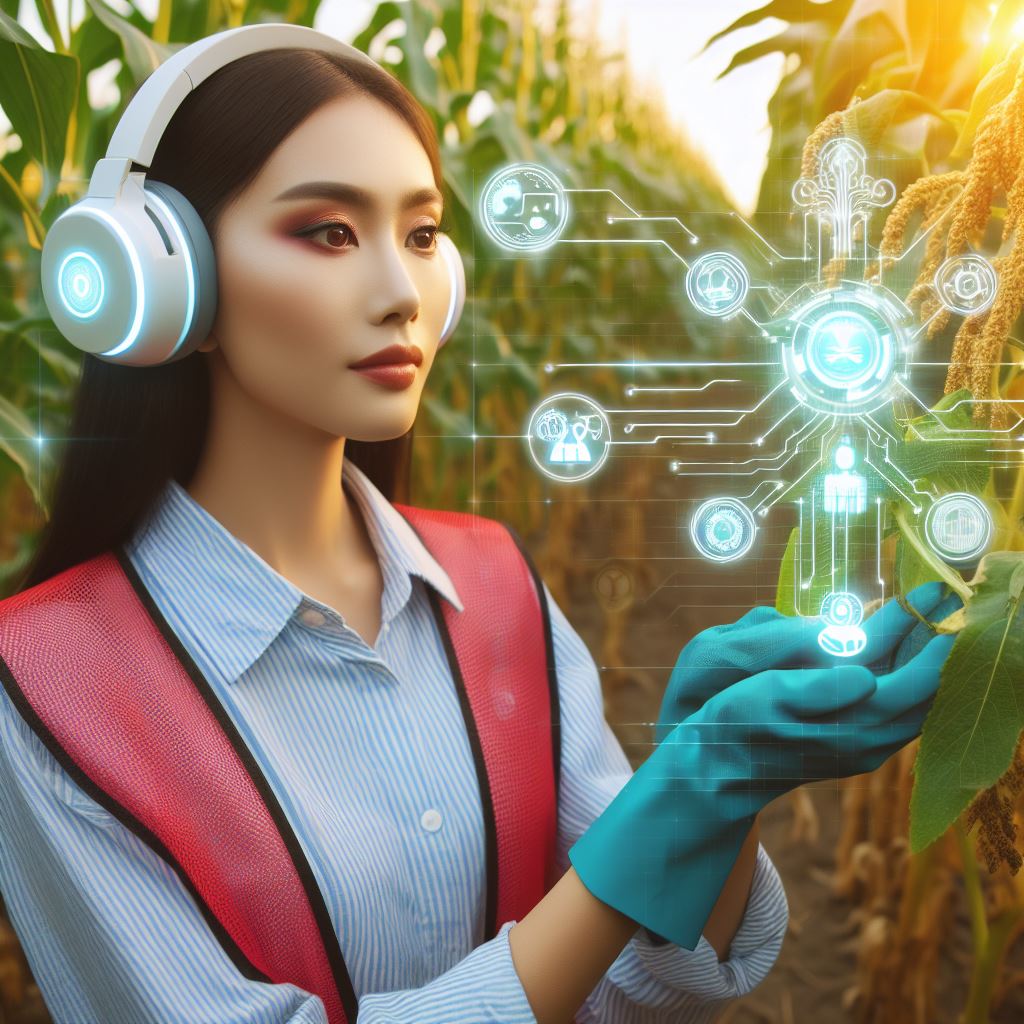Introduction
Animal farming plays a vital role in meeting the global demand for food and contributing to economic growth.
The livestock industry constantly requires innovation to address challenges and improve productivity.
This blog sectionfocuses on the innovations in livestock tech to enhance animal farming efficiency.
Livestock farming is crucial for food production, providing a reliable source of meat, milk, and eggs to meet the nutritional needs of a growing population.
To meet the surging demand for animal products, continuous innovation is essential to ensure the sustainability and profitability of the livestock industry.
The focus of this blog chapter is on livestock tech innovations that revolutionize animal farming practices.
Technological advancements in the livestock industry have significantly improved efficiency, animal welfare, and product quality.
Integrating technology in animal farming enhances monitoring, data collection, and analysis, enabling farmers to make data-driven decisions.
Innovations such as precision feeding systems optimize nutrition, reducing feed wastage and improving animal health.
Livestock tech innovations also include automated systems for temperature control, ventilation, and lighting, creating optimal living conditions for animals.
Remote monitoring devices, such as sensors and cameras, enable farmers to monitor animal behavior, health, and production remotely.
Genetic engineering and breeding technologies have revolutionized animal genetics, improving traits like disease resistance, growth rate, and feed conversion efficiency.
In general, livestock tech innovations have become indispensable for the animal farming industry, driving efficiency, sustainability, and profitability.
By embracing these advancements, farmers can enhance animal welfare, optimize resource utilization, and meet the growing demands of a hungry world.
The Role of Livestock Tech in Animal Farming
Livestock tech refers to the application of technological innovations in animal farming, and it plays a crucial role in modern agricultural practices.
Transform Your Agribusiness
Unlock your farm's potential with expert advice tailored to your needs. Get actionable steps that drive real results.
Get StartedWith its significance in improving productivity and efficiency, enhancing animal welfare, health monitoring, and promoting environmental sustainability, livestock tech has become an integral part of the industry.
Definition of livestock tech and its significance
Livestock tech encompasses a range of technologies, including sensors, data analytics, automation, and genetic advancements, aimed at optimizing animal farming practices.
Its significance lies in revolutionizing traditional methods and bringing about transformative changes in the industry.
How livestock tech enhances productivity and efficiency in animal farming
By leveraging cutting-edge technologies, livestock tech enables farmers to streamline processes, automate tasks, and track data in real-time.
This leads to increased productivity and efficiency in various aspects of animal farming, from breeding techniques to feed management and disease control.
For instance, automated feeding systems can accurately measure and dispense optimal amounts of feed, ensuring proper nutrition for livestock while minimizing wastage.
Similarly, robotic milking machines can handle the milking process, reducing human labor and improving milking precision, thereby saving time and resources.
How livestock tech improves animal welfare and health monitoring
Livestock tech plays a pivotal role in monitoring and safeguarding animal welfare, promoting healthier and happier animals.
Through the use of sensors and data analytics, farmers can monitor vital parameters such as body temperature, heart rate, and movement patterns, allowing for early detection of any abnormalities or signs of distress.
This real-time monitoring enables prompt intervention and appropriate care, ensuring timely treatment and better overall health outcomes for the animals.
Livestock tech also facilitates precise and targeted administration of medication, reducing the risk of over or under-dosage and minimizing potential adverse effects.
The positive impact on environmental sustainability
Livestock tech contributes to environmental sustainability by reducing resource consumption and minimizing negative ecological impacts.
Advanced technologies aid in optimizing feed formulations, resulting in improved digestion efficiency and reduced methane emissions from livestock.
Moreover, precision farming techniques help farmers minimize the use of water, fertilizers, and pesticides through targeted application, reducing runoff and environmental contamination.
Livestock tech also enables the efficient management of manure, turning it into a valuable resource through anaerobic digestion or nutrient-rich composting, thus mitigating the detrimental effects of excessive waste accumulation.
The positive impact of livestock tech on environmental sustainability extends beyond the farm gate, as it helps to conserve natural resources, protect biodiversity, and reduce greenhouse gas emissions associated with animal farming.
In short, livestock tech plays a critical role in modern animal farming by enhancing productivity, efficiency, animal welfare, health monitoring, and environmental sustainability.
Embracing these technological advancements is crucial for the future of the industry, as it offers numerous benefits to farmers, animals, and the environment.
Read: Automated Tractors: The Future of Ploughing
Innovations in Livestock Monitoring
In this section, we will explore various advancements in livestock monitoring technologies and how they have revolutionized the way we collect data and manage animal behaviors and health conditions.
1. Introduction to Various Advancements in Livestock Monitoring Technologies
- Wireless sensor networks have emerged as a game-changer in livestock monitoring.
- These technologies enable real-time monitoring of vital signs and behavioral patterns.
- Advancements in IoT have allowed seamless connectivity of multiple devices for comprehensive monitoring.
2. How Sensors and Wearable Devices Improve Data Collection
- Sensors attached to animals can monitor temperature, heart rate, and other physiological parameters.
- Data collected by sensors can be transmitted wirelessly to a central system for analysis.
- Wearable devices, such as smart collars, enable continuous monitoring of animal movements and behaviors.
3. The Use of GPS Tracking for Grazing Management
- GPS tracking systems provide accurate information on animal locations and movements.
- With GPS-enabled collars, farmers can track grazing patterns and optimize pasture utilization.
- Real-time data from GPS tracking can be integrated with other data sources for comprehensive monitoring.
4. Exploration of Innovative Techniques for Monitoring Animal Behaviors and Health Conditions
- Computer vision technology allows automated analysis of animal behaviors and recognition of abnormal patterns.
- Image recognition algorithms can identify signs of distress, illness, or estrus in livestock.
- Sound monitoring systems can detect coughing, sneezing, or unusual vocalizations, indicating potential health issues.
Livestock monitoring technologies have significantly improved animal welfare, farm efficiency, and overall productivity.
By leveraging these innovations, farmers can make informed decisions and take timely actions to ensure the well-being of their livestock.
Moreover, the data collected through these monitoring technologies can be further analyzed using machine learning and AI algorithms to gain valuable insights.
This can help identify patterns, predict diseases, and optimize resource allocation for better herd management.
Showcase Your Farming Business
Publish your professional farming services profile on our blog for a one-time fee of $200 and reach a dedicated audience of farmers and agribusiness owners.
Publish Your ProfileHowever, it is crucial to consider the ethical implications of implementing these technologies.
Privacy concerns should be addressed, and animal welfare should always be the top priority.
In fact, advancements in livestock monitoring technologies offer unprecedented opportunities for improving animal farming practices.
By harnessing the power of sensors, wearable devices, GPS tracking, and innovative monitoring techniques, we can ensure healthier animals, higher productivity, and sustainable farming in the future.
Read: Agri Solar Panels: Powering Farms Sustainably
Automation and Robotics in Animal Farming
Introduction to the integration of automation and robotics in the industry
In recent years, the livestock industry has witnessed a significant transformation due to the integration of automation and robotics.
These technological advancements have revolutionized the way animals are fed, milked, and managed on the farms.
How automated feeding systems optimize feeding processes
Automated feeding systems have become a game-changer for animal farming.
These systems use advanced technology to accurately dispense the required amount of feed to each animal.
By eliminating manual feeding, these systems ensure that animals receive the right nutrition at the right time, resulting in improved growth and production.
The use of robotic milkers and egg collectors in dairy and poultry farms
In dairy farms, robotic milkers have emerged as a groundbreaking solution.
These robots can independently milk cows, ensuring consistent milking routines and reducing the dependency on manual labor.
Similarly, in poultry farms, robotic egg collectors have automated the egg collection process, preventing any damage or contamination.
The benefits of robotic solutions in reducing labor and improving efficiency
The integration of robotics in animal farming has numerous benefits.
Firstly, it reduces the reliance on labor, solving the problem of labor shortage that many farms face.
Robots can perform repetitive tasks efficiently, allowing farmers to allocate their human workforce to more complex and critical responsibilities.
Secondly, robotic solutions improve overall efficiency.
With automation, feeding and milking processes are streamlined, making them more precise and consistent.
This, in turn, leads to better animal health, higher milk production, and increased farm profitability.
Furthermore, robots enable continuous monitoring of animals.
They can collect data on milk production, feed intake, and animal behavior, providing valuable insights for farmers to make informed decisions about their livestock’s health and management.
Moreover, automation and robotics enhance animal welfare.
With automated feeding, animals have access to feed round the clock, minimizing hunger and stress.
Robotic solutions also ensure that milking and egg collection processes are gentle and comfortable for animals, promoting their well-being.
Overall, automation and robotics have revolutionized animal farming.
From automated feeding systems to robotic milkers and egg collectors, these technological innovations have improved efficiency, reduced labor, and enhanced animal welfare.
With the integration of these advancements, the livestock industry is moving towards a more sustainable and profitable future.

Genetic and Biotechnological Innovations
Advancements in genetic and biotechnological applications have revolutionized animal farming, bringing about significant improvements in livestock traits and disease resistance.
1. Introduction to the advancements in genetic and biotechnological applications
Genetic and biotechnological innovations have opened doors to new possibilities in animal farming.
These technologies have paved the way for enhanced livestock traits, improved disease resistance, and more efficient reproduction techniques.
2. How genetic selection and breeding improve livestock traits
Through careful genetic selection and breeding, farmers can choose animals with desirable traits and mate them to produce offspring with even better genetic characteristics.
This process helps improve desirable traits such as milk production, meat quality, and growth rate.
By selecting animals with superior traits, such as increased milk yield or higher resistance to certain diseases, farmers can create a genetically superior herd or flock.
This not only benefits the farmers in terms of profitability and productivity but also leads to healthier and more robust animals.
3. The use of gene editing technologies for disease resistance
Gene editing technologies, such as CRISPR-Cas9, offer immense potential for improving livestock health and disease resistance.
These technologies allow scientists to make precise changes in an animal’s genetic code to eliminate or reduce susceptibility to specific diseases.
For example, researchers have successfully edited the genomes of pigs to make them resistant to a deadly virus called Porcine Reproductive and Respiratory Syndrome (PRRS).
This breakthrough has the potential to save the industry billions of dollars in losses due to disease outbreaks.
Moreover, gene editing techniques can also be used to enhance the nutritional value of animal products.
For instance, researchers have developed chickens that produce eggs rich in important nutrients such as Omega-3 fatty acids, which can benefit human health.
Showcase Your Farming Business
Publish your professional farming services profile on our blog for a one-time fee of $200 and reach a dedicated audience of farmers and agribusiness owners.
Publish Your Profile4. Exploration of biotechnological innovations in efficient reproduction technologies
Biotechnological innovations have revolutionized reproduction technologies, making it possible to produce more offspring in a shorter period and improve breeding programs.
Artificial insemination (AI) is one such technique that allows farmers to use superior genetic material from elite animals to impregnate a large number of females.
This method enables them to rapidly improve the genetics of their herd or flock without having to physically transport the animals.
Embryo transfer is another biotechnological innovation that allows farmers to maximize the reproductive potential of genetically superior animals.
Through this technique, embryos are collected from selected females and then transferred to surrogate mothers, resulting in the birth of multiple offspring carrying desirable traits.
In-vitro fertilization (IVF) is also gaining popularity in animal farming.
It involves collecting eggs from females, fertilizing them in the lab, and then transferring the resulting embryos into surrogate mothers.
This technology allows farmers to breed animals that might otherwise be unable to reproduce or have limited reproductive capabilities.
Overall, genetic and biotechnological innovations have greatly improved the efficiency of animal farming.
They have increased the potential for superior livestock traits, reduced disease vulnerability, and enhanced reproductive techniques.
As technology continues to evolve, it is anticipated that these advancements will further revolutionize the livestock industry, leading to more sustainable and productive farming practices.
Read: Soil Sensors: Enhancing Crop Yield Insights
Future Perspectives and Challenges
This section will delve into potential livestock tech advancements, address challenges, discuss ethical considerations, emphasize responsible innovation, regulation importance, and conclude positively.
Overview of the potential future advancements in livestock tech
- Improvement in precision livestock farming techniques that enable real-time monitoring and management of individual animals.
- Integration of artificial intelligence and big data analytics to optimize animal health, welfare, and productivity.
- Development of wearable devices and sensors for early detection of diseases and abnormalities in livestock.
- Implementation of advanced genetics and breeding technologies for enhanced production traits in livestock.
- Exploration of alternative protein sources such as insect farming and cellular agriculture.
The challenges and ethical considerations in implementing these technologies
- Ensuring data privacy and security in the collection and use of sensitive animal-related information.
- Addressing concerns regarding animal welfare and the potential for increased stress and anxiety due to monitoring and control technologies.
- Evaluating the environmental impact of intensive livestock farming and developing sustainable practices.
- Navigating the societal acceptance of genetically modified animals and alternative protein sources.
- Managing the potential disruption of traditional farming practices and the need for re-skilling farmers.
The importance of responsible innovation and regulation
- Establishing clear guidelines and regulations to ensure the safe and ethical use of livestock tech.
- Promoting transparency and accountability in the development and deployment of these technologies.
- Encouraging collaboration between industry, researchers, and policymakers to address potential risks and challenges.
- Investing in education and training programs to equip farmers with the necessary skills and knowledge to adopt and benefit from livestock tech.
- Engaging in continuous monitoring and evaluation of the impact and effectiveness of these technologies.
While there are challenges and ethical considerations associated with implementing livestock tech, the potential benefits are significant.
Livestock tech innovations offer opportunities for improved animal welfare, enhanced productivity, and sustainable farming practices.
Responsible innovation and regulation are crucial in ensuring the safe and ethical implementation of these technologies.
By embracing livestock tech, we can revolutionize animal farming, meet the increasing global demand for animal products, and contribute to a more sustainable and efficient food system.
Livestock tech has the potential to transform the industry and create a positive future for both animals and farmers.
With careful consideration and responsible implementation, we can overcome the challenges and embrace the benefits of livestock tech in animal farming.
Read: Hydroponics: Soil-Free Farming Tech Trends
Conclusion
In closing, the blog post discussed various innovations in livestock tech, highlighting their benefits in animal farming.
These innovations include automatic feeding systems, wearable devices, and genetic engineering.
The importance of continued innovation in livestock tech was emphasized, as it leads to increased efficiency, improved animal welfare, and environmental sustainability.
To stay informed and contribute to the advancement of animal farming, readers are encouraged to be open to adopting advanced technologies.
Being receptive to new ideas and staying updated with the latest developments is crucial.
By embracing new and innovative solutions, we can overcome the challenges faced by the agriculture industry and ensure a sustainable future for animal farming.
Therefore, it is essential for readers to stay informed about the latest advancements in livestock tech and be willing to adopt them on their farms.
Together, we can revolutionize animal farming and create a more productive and sustainable industry.




